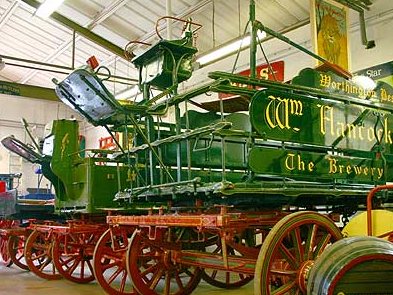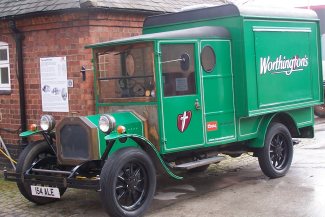 |
 |
|

|
|

|
 |
home
about
features
A-Z
books
|
|
Protz:
features
reviews
tastings
news & events
books
|

| |
Stop press: protests on the streets
Three hundred people marched through Burton-on-Trent on Friday 4 April to protest against the planned closure of the former Bass Museum by American owner Coors. A reporter on the Burton Mail said Coors had completely underestimated the feeling the closure would arouse in the town.
Coors' employees were told not to greet the marchers but in an open act of defiance they led the dray horses stabled in the museum on to the streets as the marchers went by.
The paper published a letter from a former resident of Burton, now living in Birmingham, who said she was disgusted by Coors' plans to axe the museum, which she said was a vital part of Burton's history. Coors' action, she added, stood in sharp contrast to its investment in its museum in Golden, Colorado, where its American brewery is based.
|
|
|
Beer museum - gone for a Burton?
by Willard Clarke, 04/08
The Czech Republic has two, Belgium, Denmark, the Netherlands and Poland have one each yet from June this year Britain - one of the world's great brewing nations - will not have a single national museum dedicated to beer.
Coors, the giant American brewery that owns the former Bass breweries in Burton-on-Trent, plans to close its visitor centre in June. The centre was better known under its original name of the Bass Museum.
|
|

|
It's a celebration of Burton and brewing. The town has been producing beer since the 11th century when monks first fired their coppers under the guidance of Wulfric Spot, the Earl of Mercia, who founded Burton Abbey.
But Burton became world-famous in the 19th century as a result of a new and revolutionary style of beer known as pale ale.
The Industrial Revolution made it possible for the first time to make pale malt on a commercial basis. The Burton brewers were able to use pale malt and the spring waters of the Trent Valley, rich in sulphates, to
brew beers that were bitter, hoppy and had an appealing bronze colour compared to darker milds, porters and stouts. It was the strong export version of pale ale, IPA or India Pale Ale, that built Burton's reputation
world-wide. The first brewers of golden lagers in Bavaria, Bohemia and Vienna, came to Burton to discover how pale beers were made.

|
|
Such famous Burton brewers as Allsopp, Bass and Worthington built international trade with their "India Ales". They were exported to all parts of the British empire but also found favour in the United States. At one time,
Bass was the biggest brewer in the world. Eventually, export pale ales were eclipsed by the spread of lager technology, but domestically pale ale transformed beer drinking. The dominance of pale ale and bitter in
Britain was aided by the spread of a railway system that took beer quickly to all major centres of population.
|
This fascinating history is traced in the Burton museum. Visitors can see how workers flooded into the town to make malt, brew beer, fashion wooden casks and transport it far and wide. The brewers built their own railway systems that slotted into the national system. Over the years, the museum spread it wings, also devoting space to the development of beer on a world scale. It covers such important innovations as the introduction of a pure strain of brewer's yeast in the Carlsberg laboratories in Copenhagen that improved fermentation and kept bacteria at bay.
Now this vital museum, part of the warp and weft of the British way of life, is threatened with closure. At one stage, the Bass Museum attracted a quarter of a million visitors a year but that has declined as the
centre has been under-promoted. Coors says it costs �1 million a year to fund the centre, which includes not only the displays and archives but a bar and restaurant, a bookshop, old brewery vehicles,
stables for dray horses and the Museum Brewery that produces the world-famous bottled IPA, Worthington's White Shield, as well as recreations of old Bass beers. The brewery at least is safe:
production is likely to move to a bigger pilot plant at Coors known as the Samuel Allsopp brewery.
|
|
|
Moves are under way to save the centre. On 26 March a meeting at Coors was convened by the Burton MP, Janet Dean. Representatives were present from West Midlands Museums, Libraries & Archives, the Civic
Trust, Burton Chamber of Commerce, Staffordshire County Council, East Staffordshire Borough Council, the British Guild of Beer Writers and the Campaign for Real Ale. Coors was represented by John Polglass and it was made clear to him by speaker after speaker that the company should agree to a stay of execution and extend the June deadline while alternative means of ownership and funding were investigated. For example, if the centre were given charitable status it could apply for funding from the Lottery and the National Heritage. A steering committee was set up to look into these issues and will report back but its work will be seriously undermined if the centre closes.
Meanwhile the employees at the centre have drawn up a petition against the closure that they intend to send to Prime Minister Gordon Brown and Culture Secretary Margaret Hodge.
|
|
All those that care about the history of brewing in Britain should attempt to visit the Burton Centre and sign the employees' petition.
It is important also to make your views known to Coors and to ask them to
extend the June deadline while alternative methods of ownership are sought:
.
|
*The Visitor Centre is in Horninglow Street, Burton. Current opening hours are 10-5, with last entry at 4pm. There are on-site catering and family facilities.
|
|
home
about
features
A-Z
books
|